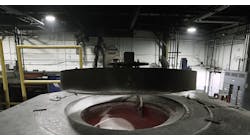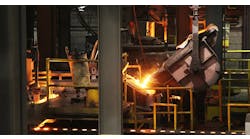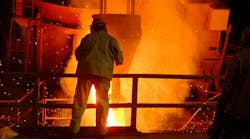A 2013 research project conducted for Allsup, a provider of Social Security disability insurance, concluded that metalcasting operations ranked third among the most dangerous jobs in the United States.1 Foundry and diescasting plant workers are frequently injured by molten-metal splashing — a hazard that also presents risks in welding and fabricating operations.2
Any worker or employee who passes near a point at which metal is heated to the molten state risks suffering an injury from a molten-metal splash. An employer’s responsibility to protect workers carries with it the potential for serious legal consequences, as well as fines for the employer if it fails to properly protect its workers.
For example, in California an automaker was fined $89,000 by the state’s occupational safety authority in connection with a November 2013 industrial accident, in which three workers were burned by molten metal at a diecasting operation in the company’s plant.3
Many foundries and diecasters, as well as steel and aluminum producers, and other industrial metal producers and processors, face the challenge of protecting their employees from the hazards of a molten-metal splash. Individuals overseeing safety efforts in these types of operations need to understand the types of fabrics and equipment available to help prevent injury during a molten-metal incident and avoid infractions of the U.S. Department of Labor’s Occupational Safety and Health Administration (OSHA) and National Fire Protection Association (NFPA) standards.10
Selecting suitable fabric
Molten-metal splash hazards commonly occur when moisture or wet materials and tools come into contact with molten metal, causing the metal to erupt. With temperatures that can reach over 3,500°F, even a drop of this material can adhere to exposed skin or material, and lead to serious burns and other severe consequences.
One challenge that a manufacturer faces is selecting appropriate personal protective equipment (PPE) for its workers or employees. OSHA 1910.32 places on employers the sole responsibility for selecting the types of PPE to be used by its employees.
Government reports note that the majority of burn injuries are not due to molten metal exposure itself, but rather by the clothing igniting and continuing to burn.4 Once exposed to the atmosphere, most clothing fabrics will continue to burn, causing severe injuries to the skin.
Using flame-resistant clothing (FRC) can provide thermal protection at the exposure area during a molten-metal splash incident, limiting the body burn percentage of such an exposure.5
Not all FRC will protect the wearers in the same manner, and fabrics react very differently when exposed to different metals. OSHA 1910.132 requires employers to assess the workplace to determine if hazards are present and select PPE that properly fits each affected employee.6
ASTM sets the standards for evaluating worker protection. ASTM 995 is the standard test method used to evaluate a material’s thermal resistance to a molten substance by measuring heat transfer.7 This test method includes visual inspection to determine the material’s resistance to molten substance.5
The level of protection that is appropriate to a situation depends upon the weight of the fabric and its composition. After the source of the ignition is removed, flame-resistant garments will self-extinguish, limiting the body burn percentage. Non-flame-resistant fabrics will continue to burn, potentially causing severe contact burns to the skin.
Take proper care
According to ASTM F2757-09, when FR garments are laundered at home, they should be washed according to the instructions on their care labels.8 Often, these instructions provide that FR clothing should be turned inside out when laundering, that fabric softeners and chlorine bleach should not be used, and that specific water temperatures should be used during the wash cycle. Also, potentially flammable contaminants that attach to garments during the workday should be removed from garments during the wash process.
To help ensure that garments are washed optimally, many manufacturers engage a uniform rental program for industrial laundering, to help guard against home laundering imprecision. By using appropriate water temperatures, water softness and detergents or chemical agents, industrial laundering allows manufacturers to improve the wash process of flame-resistant garments.
Repairs of FR garments also should not be attempted without using the proper materials, which is why many manufacturers rely on industrial launderers to perform those repairs with flame-resistant thread and other materials.
The Importance of Primary Protection
In addition to identifying the right PPE, organizations face challenges ensuring workers wear the PPE provided. FRC is only considered adequate protection by OSHA for circumstances in which the potential molten-metal splash can be measured in droplets and the amount of material exposed at the time of a splash is minimal. OSHA 1910.132 requires employers to assess the workplace to determine if hazards are present, or are likely to be present, which necessitate the use of PPE.4
Secondary protective apparel – such as flame-resistant shirts and pants — can be worn under primary protective clothing such as jackets, aprons, or capes. Primary protective gear should be worn during work activities such as charging, sampling, or temperature measuring, or whenever there is close proximity to molten metal.9 Primary PPE includes safety glasses, a face shield, hard hat, hearing protection, jacket, apron, gloves, leggings, spats, cape and sleeves, and must be made of aluminized glass fabrics.Aluminized glass outerwear will deflect about 90% of the heat away from the body. 7
Enhancing safeguards
Manufacturers must independently identify the types of hazards in their workplace in order to select the appropriate fabric and the proper PPE. Manufacturers may use an industrial laundry to help them fit their employees in comfortable apparel that it is laundered and repaired outside of the home to help maintain the garments’ integrity.
Dave Rehm is the protective apparel manager for Cintas Corporation, a supplier of industrial laundry and professional uniforms. For more information, visit www.cintas.com/FlameResistantClothing .
Endnotes
1. Allsup. “Allsup Study of Workplace Injuries.” www.allsup.com. 23 July 2013.
2. FM&T. “Molten Metal Splash and Furnace Refractory Safety” www.foundrymag.com, 11 August 2009.
3. Mercury News. “Tesla Motors faces $89,000 in fines for incident that injured workers at Fremont facility.” www.mercurynews.com. 1 May 2014.
4. Plastics Magazine. “Safety Solutions: Defining FR – Flame Resistant Fabrics.” 1 August 2011.
5. Occupational Safety & Health Magazine. “Flame Resistant Fabrics Clothing Basics.” 1 November 2010.
6. Occupational Safety & Health Administration. “1910.132.”
9. Inductotherm. “The Induction Foundry Safety Fundamentals Guide That Might Save Your Life.”
10. Information provided here is for general informational purposes only and does not constitute legal or professional safety advice. This information should never be a substitute for conferring directly with professional legal counsel or safety professionals with respect to your particular legal and safety needs in the appropriate state or other jurisdiction. An employer should not rely upon or take any action with respect to any specific legal, regulatory or safety matter based on information contained in this article. Cintas disclaims any and all liability with respect to any action you do or do not take in reliance on any material in this article.









